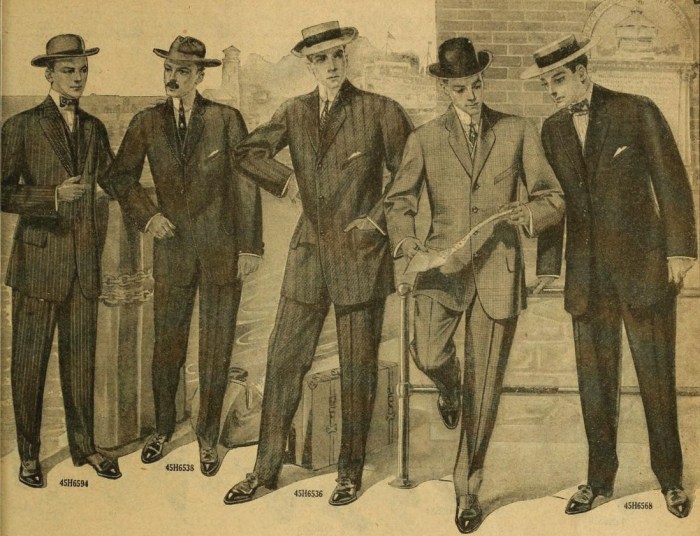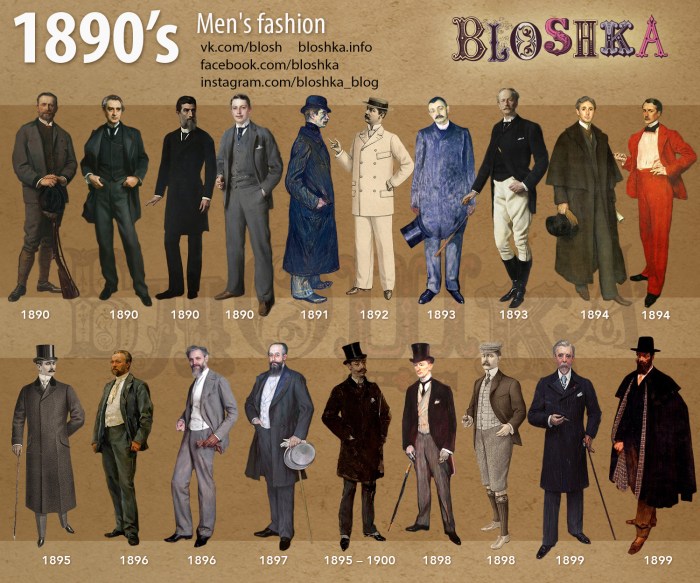1810s Mens Fashion A Gentlemans Style Guide
Men’s Fashion in the 1810s: An Overview
1810s mens fashion – The 1810s in men’s fashion marked a period of refined elegance, influenced by both the lingering effects of the Napoleonic era and the burgeoning Romantic movement. Silhouettes emphasized a lean, elongated figure, a departure from the bulkier styles of the previous decades. This era saw the refinement of existing garments and the introduction of new styles that would define masculine attire for years to come.
Key influences included military styles, the ongoing emphasis on classical aesthetics, and a growing desire for comfort and practicality.
Overall Aesthetic and Key Influences, 1810s mens fashion
The overall aesthetic of men’s fashion in the 1810s can be characterized as refined and elegant, with an emphasis on clean lines and tailored fits. Military styles, particularly those associated with the Napoleonic Wars, played a significant role, influencing the design of coats and trousers. Classical ideals also continued to inspire the choice of fabrics and the overall silhouette, creating a look that was both stylish and sophisticated.
The Romantic movement, with its emphasis on individualism and emotion, subtly impacted fashion through the choice of colors and accessories, allowing for a degree of personal expression.
Prominent Silhouettes and Shapes
The dominant silhouette of the 1810s was a lean, elongated figure, achieved through the use of high-waisted trousers or breeches and long, fitted coats. The shoulders were generally less padded than in previous decades, creating a more natural, less bulky appearance. Coats were often long and fitted, while trousers were either tightly fitted or full, depending on the style and occasion.
The overall effect was one of sophistication and restraint.
Comparison of Early and Late 1810s Fashion
| Feature | Early 1810s | Late 1810s |
|---|---|---|
| Coat Length | Generally longer, often reaching the knees or below | Slightly shorter coats became more common |
| Trousers/Breeches | High-waisted breeches remained popular, but trousers started gaining ground | Trousers increasingly replaced breeches as the preferred lower garment |
| Colors | Darker, more muted colors were prevalent | A slightly wider range of colors, including lighter shades, emerged |
| Accessories | Emphasis on cravats and neckcloths | Similar accessories continued, but with variations in style and materials |
Men’s Tailored Clothing: Coats and Jackets
The coats of the 1810s represented the pinnacle of men’s tailoring. Several distinct styles existed, each serving different purposes and reflecting varying levels of formality. The choice of fabric, construction techniques, and detailing played crucial roles in conveying social status and individual taste.
Men’s fashion in the 1810s was characterized by high-waisted trousers, fitted tailcoats, and cravats. For a broader look at historical menswear and modern interpretations, you might find inspiration on sites like mens fashion style tumblr , which showcases a wide range of styles. Returning to the 1810s, note the prevalence of muted colors and the importance of well-tailored garments in expressing one’s social standing.
Types of Coats, Fabrics, and Construction
The frock coat, a versatile and popular choice, featured a long, fitted silhouette, often reaching the knees. Tailcoats, with their characteristic tails in the back, were reserved for more formal occasions. Spenders, shorter, fitted jackets, offered a more casual alternative. Common fabrics included wool, cashmere, and velvet, with the choice often reflecting both the season and the wearer’s social standing.
Construction details such as lapels, collars, and buttons varied depending on the coat style, but generally showcased meticulous craftsmanship.
Visual Representation of a Frock Coat
Imagine a dark blue wool frock coat, reaching mid-calf. The coat features a notched lapel, a high-closing collar, and several rows of closely spaced buttons extending down the front. The sleeves are long and fitted, ending just above the wrist. The coat is single-breasted, with a relatively straight silhouette, gently curving in at the waist to accentuate the wearer’s shape.
The fabric has a subtle sheen, indicating high-quality wool. The overall impression is one of elegance and sophistication.
Trousers and Breeches: 1810s Mens Fashion

Source: vintagedancer.com
The transition from breeches to trousers was a defining characteristic of men’s fashion in the 1810s. While breeches continued to be worn, particularly by older men and those in more formal settings, trousers gained increasing popularity, especially among younger generations. Both styles offered distinct aesthetic and practical considerations.
Styles, Fabrics, and Fit
Breeches, typically knee-length, were often made of fine wool or velvet, and were worn with stockings and shoes or boots. Trousers, increasingly full-length, were generally made of wool or cotton and were often worn with gaiters or spats. The fit of trousers varied; some were relatively tight-fitting, while others were looser and more comfortable. Colors ranged from dark grays and browns to lighter shades, depending on the occasion and the wearer’s preference.
The increasing prevalence of trousers reflects a shift towards practicality and comfort.
Accessories for Trousers and Breeches

Source: bloshka.info
- Gaiters: Fabric coverings worn over the lower legs, offering protection and warmth.
- Spats: Short gaiters that covered only the ankles and shoes.
- Stockings: Woolen or cotton stockings worn under breeches or trousers.
- Shoes and Boots: A variety of styles, from simple leather shoes to high boots, completed the ensemble.
Shirts, Waistcoats, and Undergarments
The undergarments and layering of clothing in the 1810s provided both comfort and a foundation for the more visible elements of the male wardrobe. The careful selection of these pieces played a role in achieving the desired overall silhouette and ensuring the wearer’s comfort.
Shirt Styles, Waistcoats, and Undergarments
Shirts were typically made of linen or cotton, with high collars and long sleeves. The collars were often starched and stiffened to maintain their shape. Waistcoats (vests), worn beneath the coat, came in various styles and fabrics, adding another layer of color and texture to the outfit. Common materials included velvet, silk, and cotton. Undergarments included drawers, usually made of linen or cotton, and undershirts, offering a layer of warmth and absorbency.
A Typical 1810s Gentleman’s Outfit
A typical outfit might consist of linen drawers and a cotton undershirt, followed by a high-collared linen shirt, a finely tailored waistcoat in a contrasting color or pattern, a dark-colored frock coat, high-waisted trousers, and polished leather boots. Accessories such as a cravat, a top hat, and a walking cane would complete the look, depending on the occasion and the wearer’s personal style.
Accessories and Footwear
Accessories and footwear played a significant role in completing the 1810s gentleman’s ensemble. These items not only served practical purposes but also functioned as important indicators of social status and personal taste. The careful selection and arrangement of accessories demonstrated a man’s attention to detail and his place within society.
Accessories and Footwear Styles
Cravats and neckcloths, intricately tied and arranged, were essential neckwear. Hats, such as top hats and bicorne hats, were important status symbols. Canes served both as walking aids and fashionable accessories. Footwear ranged from simple leather shoes to elegant boots, often reflecting the occasion and the wearer’s social standing. The careful coordination of these elements created a cohesive and stylish overall appearance.
Accessories and Personal Style
The style of cravat, the choice of hat, and even the type of cane could all reflect personal style and social standing. A carefully chosen walking stick, for example, might signal a particular profession or social group. The attention paid to accessories highlighted the importance of sartorial details in expressing individuality and social position.
Influence of Social Class and Profession
The fashion choices of men in the 1810s were significantly influenced by their social class and professional roles. The quality of fabrics, the style of garments, and the choice of accessories all served as visual markers of a man’s position in society. This visual language of clothing allowed for immediate recognition and understanding of social standing.
Social Class and Clothing
- Upper Class: High-quality fabrics (silk, velvet, fine wool), elaborate tailoring, and a wide array of accessories.
- Middle Class: Good quality, but less expensive fabrics, simpler tailoring, and fewer accessories.
- Working Class: Durable, inexpensive fabrics, simple, practical clothing, and minimal accessories.
Professional Roles and Clothing
Certain professions had specific sartorial requirements or conventions. Military officers, for example, wore distinctive uniforms, while lawyers and clergymen adopted particular styles of clothing that reflected their roles. These distinctions reinforced professional identity and social hierarchy.
Illustrations of 1810s Men’s Fashion
Visual representations of 1810s men’s fashion offer a rich understanding of the era’s sartorial styles. Paintings, engravings, and other visual media capture not only the clothing itself but also the social contexts in which it was worn. These images allow us to see how different garments and accessories were combined to create a complete look, reflecting the wearer’s social status and individual taste.
Detailed Description of a Painting
Imagine a painting depicting a group of gentlemen gathered in a grand ballroom. The men are dressed in various styles of frock coats and tailcoats, some in darker colors, others in lighter shades. Their waistcoats are visible beneath their coats, adding pops of color and texture. Their cravats are carefully tied, showcasing a variety of knots and fabrics.
Some men wear top hats, others bicorne hats, and the overall impression is one of elegance and formality. The scene is richly detailed, showcasing the high quality of the fabrics and the meticulous craftsmanship of the clothing.
Scene Depicting Men from Different Social Classes
Imagine a scene set in a bustling London street. A wealthy gentleman in a finely tailored dark blue frock coat, a top hat perched jauntily on his head, walks past a working-class man in a worn brown coat and simple trousers. The contrast in their clothing highlights the stark differences in their social standing. The wealthy gentleman’s attire speaks of affluence and leisure, while the working man’s clothes reflect his daily labor.
The scene effectively captures the visual language of clothing as a marker of social class in 1810s London.
FAQ
What were common colors in 1810s men’s fashion?
Dark colors like black, dark blue, and brown were prevalent, though muted greens and grays were also seen. Brighter colors were generally reserved for accessories or linings.
How did men’s hairstyles change during the 1810s?
Hair was generally styled short and neat, often powdered. The sideburns were popular, and the overall look was one of controlled elegance.
What were some common materials used for men’s clothing in the 1810s?
Wool was a dominant fabric for coats and trousers, while cotton and linen were used for shirts and undergarments. Silk was often used for linings and accessories.
Did the style of men’s footwear vary by social class in the 1810s?
Yes, boots were more common among the working class and those involved in outdoor activities, while finer leather shoes were favored by the upper classes.





















